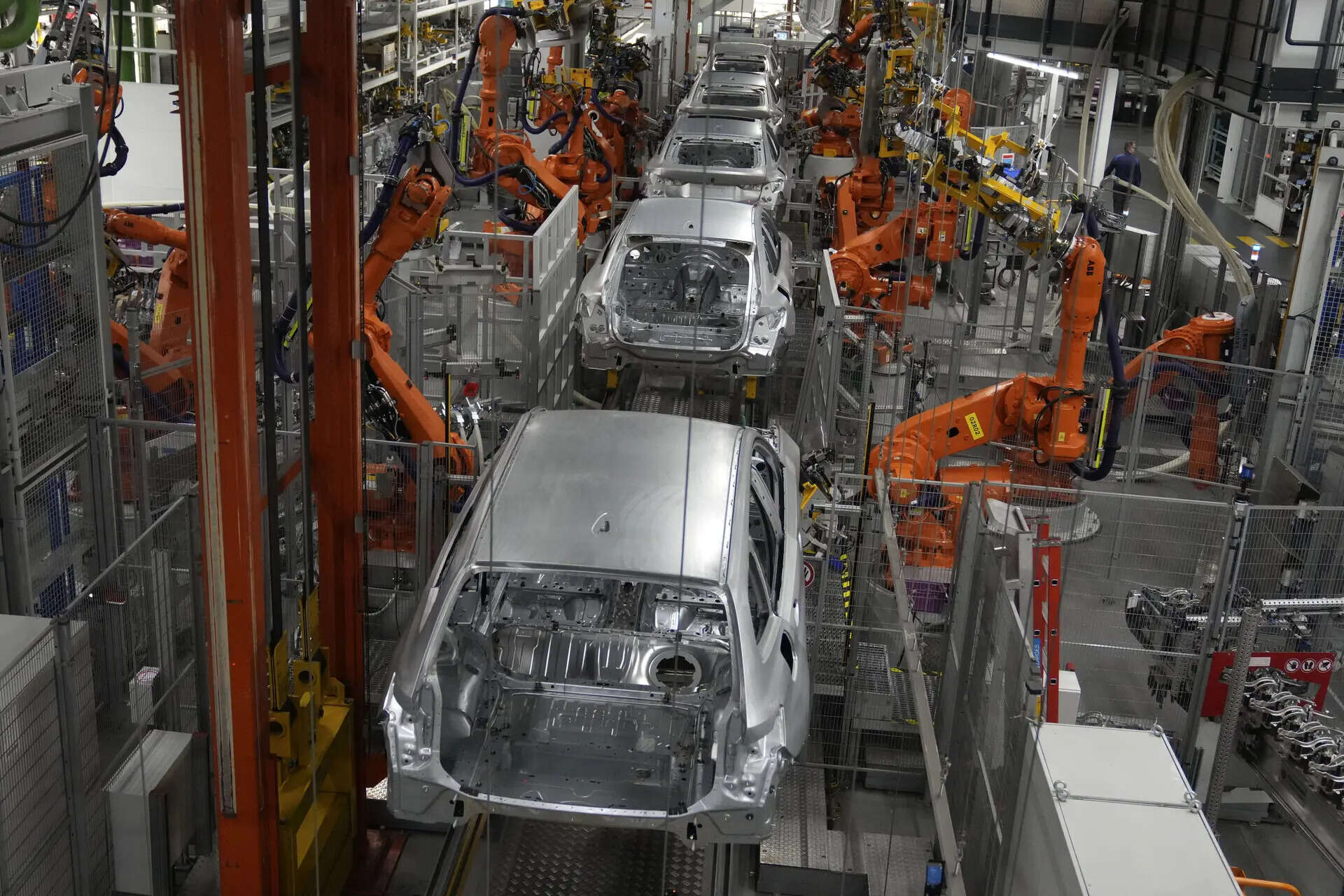 In the world’s largest car-producing countries such as Japan, Germany & S Korea, thousands of small and midsize parts suppliers form the backbone of mfg sector.
In the world’s largest car-producing countries such as Japan, Germany & S Korea, thousands of small and midsize parts suppliers form the backbone of mfg sector.“>
In a factory in Hekinan, a seaside town southwest of Tokyo, machines spit hot metal rods into baskets. On a recent Monday, afternoon light poured in through yellowed windows, and the air inside was hot and smelled of metal shavings.The plant, operated by an 84-year-old Japanese automotive parts maker, Asahi Tekko, produces components that are fitted into Lexus and Land Cruiser models at nearby Toyota factories. Many of those vehicles are then shipped to the United States.For decades, the route has been one of many supply lines that underpin the automotive industry. Now, however, it is a source of unease for Asahi Tekko, as the company grapples with recent fluctuations in U.S. trade policies.When President Donald Trump laid down a 25 per cent tariff on Japanese automobiles and parts this year, Tetsuya Kimura, the CEO of Asahi Tekko, thought, “Is he actually going to do something like that?” Kimura recalled. He added, “The thinking seemed so oversimplified.”
Asahi Tekko has not yet felt the full effect of the tariffs, which are to be set at 15 per cent as part of Japan’s recent trade agreement with the Trump administration. Still, the uncertainty is unnerving. Kimura fears they could hurt American demand for cars and cut the need for his parts.
“When it comes to how much impact these tariff rates will have, we don’t have a calculus,” he said.
Under the Trump administration, virtually all of the world’s largest carmaking countries are subject to double-digit tariffs on automobiles and auto parts. While big foreign manufacturers of cars, such as Toyota, have the profits to absorb the added costs, industry experts expect a more devastating effect on the dense networks of auto parts suppliers that make everything from pistons to wiring.
In the world’s largest car-producing countries such as Japan, Germany and South Korea, thousands of small and midsize parts suppliers form the backbone of the manufacturing sector. The United States is the largest purchaser of finished vehicles assembled in those countries, and for Japan and South Korea, it is also the largest direct importer of components.Unlike some carmakers, suppliers often operate on razor-thin profit margins and don’t have the money to invest in shifting production to other countries. The tariffs are also just the latest problem for companies contending with a shift to electric vehicles that could make many of the parts they produce for combustion engine vehicles obsolete.
“Smaller players in the auto industry don’t have levers they can pull to adjust to the tariffs,” said Michael Robinet, a vice president at S&P Global Mobility, an automotive intelligence provider. The shift to electric vehicles and rising competition from Chinese competitors are already causing suppliers to consolidate. “Tariffs are just an accelerator,” he said.
Japan’s auto parts sector employs more than 600,000 people across some 20,000 companies, many of which are industrial lifelines in rural areas of the country. South Korea’s parts industry employs about 330,000, while in Germany, suppliers make up about a third of the more than 700,000 people in the automotive sector.
Disruptions to trade flows are already becoming apparent. In Japan, the value and volume of auto parts shipped to the United States have fallen each month since May, when tariffs on them went into effect. In July, the value of auto parts shipped to the United States dropped 17.4 per cent from a year earlier.
In a recent survey by the Korea Chamber of Commerce and Industry, South Korea’s largest business organization, 81 per cent of automobile and auto component companies said tariffs would hurt their earnings.
Tariffs have already cost the German auto industry billions of dollars, said Hildegard Müller, the president of the German Association of the Automotive Industry. Last month, the European Union reached a deal with the United States that would lower auto tariffs to 15%, but Müller said the agreement had brought no “clarity or improvement” for businesses.
In details of the U.S.-EU agreement published last week, the two sides said the United States would lower tariffs on vehicles only after Europe took steps to lower its own tariffs on American goods. Japan and South Korea are also waiting for the lower auto tariffs they were promised in their own trade deals with the United States to take effect.
Last month, the International Monetary Fund projected that U.S. tariffs would significantly weigh on growth in Germany, as well as in South Korea and Japan. It forecast that the three economies would expand this year and next at only around two-thirds the pace that it had predicted in January.
This has left governments scrambling to offer relief. South Korea has set aside around $11 billion to support manufacturers. Citing the tariffs as a “national crisis,” the Japanese government of Prime Minister Shigeru Ishiba has allocated $6.3 billion to support affected businesses and plans to open 1,000 consultation centers across the nation.
At the same time, new challenges are emerging. Last week, the Trump administration announced that 50 per cent duties are now in effect on more than 400 additional kinds of products, including many car parts, that contain aluminium or steel. Those products were additions to an existing list of tariffed metal goods that already included many other auto components.
For some officials and industry workers in Japan, South Korea and Germany, the looming fear is that rising tariff costs will compel some suppliers to shift production from their home countries to the United States. This would effectively hollow out their domestic industries and weigh on economic growth.
In April, the Trump administration agreed to provide a partial, two-year reprieve for auto parts tariffs for companies that finish assembling cars in the United States. Trump, who has championed the tariffs as a way to bring back lost manufacturing jobs, said he was giving the industry “a little bit of help” with the transition to U.S.-made components.
This temporary relief followed pleas from U.S. automakers, including General Motors, which gets many parts from Mexico and South Korea. The companies warned that the previously announced levies would raise production costs and significantly cut into profits.
The Trump administration has said manufacturers in America would have to get their components domestically to avoid higher tariffs after the two-year reprieve.
In South Korea, as well as Japan and Germany, many suppliers had already shifted some production to the United States in recent decades. But some suppliers have resisted moving over to avoid higher American production costs, according to Seongdae Cho, the director of the trade studies and cooperation department at the Korea International Trade Association, one of the country’s biggest business organisations.
When the reprieve ends, companies still supplying the American market from abroad would be at a significant disadvantage. “They may come at a crossroads between being replaced and having to produce in the US,” he said.
In Japan, Kimura, the CEO of Asahi Tekko, said the company, for now, wasn’t planning on significantly changing its operations. It will continue to monitor demand in the U.S. market while trying to increase efficiency, particularly by using more artificial intelligence.
During a recent interview, Kimura asked a personalized bot he had created of himself on ChatGPT, called “Kimutetsu,” how to reduce the effect of tariffs on his business. The bot responded that he should use the external pressure as a “springboard” to change the company’s structure and make it more profitable.
Join the community of 2M+ industry professionals.
Subscribe to Newsletter to get latest insights & analysis in your inbox.
All about ETAuto industry right on your smartphone!
- Download the ETAuto App and get the Realtime updates and Save your favourite articles.





